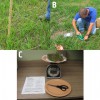 El forraje sirve como fuente primaria de nutrientes para la industria ganadera en Florida. El uso eficiente de esta fuente nutricional es crítico para la supervivencia de los agricultores y rancheros de dicho estado. El estimar la cantidad de forraje en potreros puede proveer información útil a la hora de tomar decisiones acerca del manejo de nuestros recursos. Debe de haber suficiente material en el predio para justificar el costo de utilizar el equipo para cosechar (por ejemplo, precio de compra del equipo, renta, costo del combustible a invertirse, y el costo de la mano de obra). Sin esta información, el predio debe ser sometido a pastoreo. Esta publicación contiene las instrucciones para la implementación de un método simple que nos permite determinar la cantidad aproximada de forraje en campos de heno y potreros.This 2-page fact sheet was written by T. Wilson, C. Sanders, J. Breman, y L. Sollenberger. Traducido por J. Bosques, and published by the UF Department of Agronomy, January 2014.
El forraje sirve como fuente primaria de nutrientes para la industria ganadera en Florida. El uso eficiente de esta fuente nutricional es crítico para la supervivencia de los agricultores y rancheros de dicho estado. El estimar la cantidad de forraje en potreros puede proveer información útil a la hora de tomar decisiones acerca del manejo de nuestros recursos. Debe de haber suficiente material en el predio para justificar el costo de utilizar el equipo para cosechar (por ejemplo, precio de compra del equipo, renta, costo del combustible a invertirse, y el costo de la mano de obra). Sin esta información, el predio debe ser sometido a pastoreo. Esta publicación contiene las instrucciones para la implementación de un método simple que nos permite determinar la cantidad aproximada de forraje en campos de heno y potreros.This 2-page fact sheet was written by T. Wilson, C. Sanders, J. Breman, y L. Sollenberger. Traducido por J. Bosques, and published by the UF Department of Agronomy, January 2014.
http://edis.ifas.ufl.edu/ag379
Tag: Jacque W. Breman
Field Symptoms of Boron Toxicity and Deficiency in Florida Peanuts (SL366/SS567)
 Boron is an essential micronutrient needed by peanut to prevent “hollow heart” and to provide for sufficient plant growth, but it can be a challenge to manage for peanut production on sandy soils. There may be times when peanut growers, extension agents, and consultants find field symptoms when either boron toxicity or boron deficiency is the cause of peanut yield loss and low kernel quality. This 4-page fact sheet reviews the boron management strategy in Florida, presents information on boron sufficiency and toxicity levels from the literature, and provides photographs of field symptoms that can be used by growers and Extension agents. was written by J. W. Breman, W. D. Thomas, H. E. Jowers, and R. S. Mylavarapu, and published by the UF Department of Soil and Water Science, May 2012.
Boron is an essential micronutrient needed by peanut to prevent “hollow heart” and to provide for sufficient plant growth, but it can be a challenge to manage for peanut production on sandy soils. There may be times when peanut growers, extension agents, and consultants find field symptoms when either boron toxicity or boron deficiency is the cause of peanut yield loss and low kernel quality. This 4-page fact sheet reviews the boron management strategy in Florida, presents information on boron sufficiency and toxicity levels from the literature, and provides photographs of field symptoms that can be used by growers and Extension agents. was written by J. W. Breman, W. D. Thomas, H. E. Jowers, and R. S. Mylavarapu, and published by the UF Department of Soil and Water Science, May 2012.
http://edis.ifas.ufl.edu/ss567
Estimating Amount of Forage in Hay Fields and Pastures (SSAGR360/AG369)
 Forage serves as the primary source of nutrients for livestock in Florida, and efficient use of forage is critical to the livelihood of Florida farmers and ranchers. Estimating the amount of forage in a pasture can provide useful information when making management decisions. There must be enough material in the field to justify the cost of using harvesting equipment; otherwise, the area should be grazed. This 2-page fact sheet contains instructions for a simple method to determine the approximate amount of forage in hay fields and pastures. Written by T. Wilson, C. Sanders, J. Breman, and L. Sollenberger, and published by the UF Department of Agronomy, March 2012.
Forage serves as the primary source of nutrients for livestock in Florida, and efficient use of forage is critical to the livelihood of Florida farmers and ranchers. Estimating the amount of forage in a pasture can provide useful information when making management decisions. There must be enough material in the field to justify the cost of using harvesting equipment; otherwise, the area should be grazed. This 2-page fact sheet contains instructions for a simple method to determine the approximate amount of forage in hay fields and pastures. Written by T. Wilson, C. Sanders, J. Breman, and L. Sollenberger, and published by the UF Department of Agronomy, March 2012.
http://edis.ifas.ufl.edu/ag369
PP252/PP168 Barley Yellow Dwarf Virus Confirmed in Argentine Bahiagrass in Northeastern Florida
PP-252, a 4-page illustrated fact sheet by J. Breman, J. DeValerio, A. Gevens, R. Cullen and W. Bird, describes this viral disease of Argentine bahiagrass which has appeared in northeast Florida, the pathogen and hosts, symptoms, and disease management. Includes references. Published by the UF Department of Plant Pathology, April 2008.
http://edis.ifas.ufl.edu/PP168